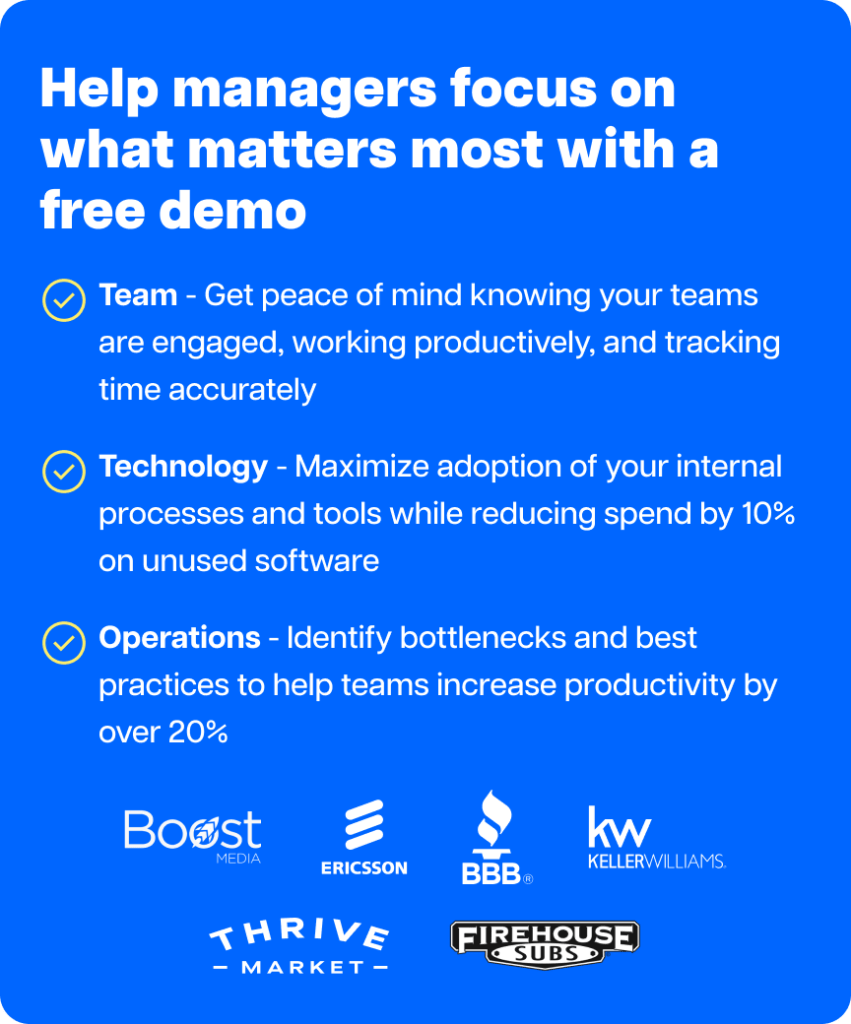Managing employee tardiness, unscheduled and unexcused absence, etc., can be difficult in any business. These unscheduled leaves negatively impact employee productivity, team performance, and consequently, the firm’s income.
Fortunately, you can solve these attendance issues by creating an absence policy.
In this article, we’ll tell you what an effective absence policy will include and why you need one. We’ll also share a sample absence policy template for reference.
This article includes:
(Click on the link to go to a particular section)
- What is an Absence Policy?
- 5 Essential Aspects of an Absence Policy
- A Free Absence Policy Template
- Why Do You Need an Absence Policy?
Let’s get started.
What is an absence policy?
(If you’re only looking for the free template, skip ahead to the sample absence policy template section.)
An absence policy (or an attendance management policy) is a document that helps you deal with attendance violations, manage employee leaves and absence.
A good absence policy educates the employees on how the firm deals with excessive absenteeism and tardiness. It also explains the guidelines for different types of leaves like sick leave, unpaid leave, etc.
5 essential aspects of an absence policy
Your absence or attendance policy template must be practical and feasible.
Let’s look at a few qualities of a good employee attendance policy template:
1. Clear guidelines
Your employee attendance policy should clearly define guidelines and attendance issues.
It can also include the consequences of attendance infractions like absenteeism and motivate your employees to adhere to the attendance policy.
Additionally, when creating your policy, ensure that your employees understand what you expect from them. For example, if you don’t add a cap on the length of a lunch break, your employees could take more breaks than necessary and be less productive.
Similarly, you must tell your employees if you expect them to work over the weekend while working on urgent projects.
2. Differentiate between absences
Sometimes, employees may find it difficult to differentiate between the different types of absences. Your attendance policy must explain the various absences and the consequences for each one of them.
Employee absences can be usually divided into these categories:
- Approved leave or excused absence: Absence approved by the manager.
- Unscheduled absence: Urgent absences that are informed a few work hours prior. Such absences can be due to emergencies, such as the death of an immediate family member.
- No-show: Absences where an employee doesn’t inform you of their absence beforehand.
- Tardiness: Partial absence caused by starting work late. In some companies, if an employee arrives 30 minutes late, they are considered a no-show.
- Sick leave: Sudden absence caused by the illness of a staff member.
Different absences affect your team and firm differently. You can decide the penalty for each depending on the effect it has on your team.
3. Have a progressive disciplinary policy
Your policy template should set realistic expectations and penalties.
For example, you shouldn’t take any action against an employee who reached the office 30 minutes late due to heavy traffic.
If you penalize the employee for something they can’t control, it may decrease their job satisfaction – which can also reduce employee retention.
Your employee attendance policy template must be empathetic and progressive.
A progressive disciplinary policy will guide employers to take action against employees only after careful observation and consideration.
For instance, an employee with two no-shows on their record can be given a verbal warning in three months. Similarly, an employee who has been absent without informing the manager for more than four days can be suspended as it can be considered job abandonment.
Likewise, employees who have a good attendance record can be given an attendance bonus or similar benefits.
4. Consider employee well being
Your employee attendance policy should keep the best interest of employees in their minds.
You should run your policy by your employees before you implement it. This way, you can ensure that they won’t find it inconvenient and can follow the guidelines.
For example, if more than half of your employees feel the grace period while starting and ending a scheduled shift should be ten minutes, you can consider extending it. Similarly, you can allow your staff members to work remotely once a week if most of them are open to this idea.
5. Explain in detail
Your policy template should have a certain structure and include relevant points. This can help you make a clear and efficient policy.
Here are some important elements to consider:
- Scope of the attendance policy.
- Calculating absence infractions.
- Eligible employees selection criteria.
- Differences in absenteeism, tardiness, and unforeseen absences.
- Responsibility of the supervisor.
- Disciplinary actions.
By explaining these points, you can help your employees understand the different rules and the implications of breaking them. Additionally, your attendance policy should ideally be included in the employee handbook so that your employees can access it easily.
Wondering how to make an employee handbook?
Check out our perfect employee handbook template.

Sample absence policy template
Here’s a sample template of absence management policy for your reference:
A. Introduction
We, at [Company Name], understand the contribution our employees make to our success.
We value their well-being and will take necessary steps when they fall ill.
The main purpose of our company’s attendance and absence policy is to inform employees about the importance of them being punctual. This absence policy explains what we expect from employees and how we will work to improve attendance.
We welcome contributions from employees in developing and implementing this policy.
B. Key principles
[Company name]’s absence policy is based on the following principles:
- As a responsible employer, we offer paid sickness absence (explained in detail in the [Relevant Document Name]).
- We believe punctuality and regular attendance is important for our mutual growth. Therefore, we prefer to maintain good levels of employee attendance.
- We will support employees who are absent for genuine reasons like the death of immediate family members, jury duty, or other requirements. This support extends to the following:
- ‘Personal Leave’ for necessary absences not caused by sickness.
- Ability to take their annual leave flexibly.
- Sick pay will be valid only for a fixed number of sick days.
- Rehabilitation support in cases of attendance policy long-term sickness.
- We will help our employees who have to follow special work guidelines by offering flexible hours.
- We will consult an occupational health officer if we learn an employee is physically unwell. The officer will advise the employee and their supervisor on ways to improve the former’s well-being and mental health.
- We respect the confidentiality of all information relating to our employee’s absence and sickness. Therefore, this policy will follow the Medical Records Confidentiality Act Of 1995.
C. Notification of absence
An employee who is going to be absent from work should inform their supervisor about the leave [xx hours] before their start time.
Failure to call-off one hour before a shift will result in a ‘no call no show.’
Employees should also:
- Explain their illness and specify they will be returning to work. They can request work absences from the human resources department.
- Share tasks that require immediate attention with their supervisor so that the latter can reassign the work to other employees to ensure smooth workflow.
An employee who has been absent for three or more consecutive days must provide evidence, such as a doctor’s note, to avail statutory sick pay.
Excused or unpaid leave can be granted for funerals, jury duty, bereavement, childbirth, car accidents, medical appointments, and unavoidable emergencies. In these cases, employees must provide documentation to prove a reason for the time off.
Note: The company will not entertain any absences which can’t be backed up with proof. We will take appropriate disciplinary action if the reason for the leave is not forthcoming or is not thought to be satisfactory.
D. Calculation of attendance infractions
Policy violations will be added as points, and appropriate action will be taken when it reaches a certain threshold.
We at [company name] follow this point system when maintaining our attendance records:
- Absent with calls: 1 point
- Absent, no call: 2 points
- Tardy: ½ point
- Early departure: ½ point
- Late return to work from lunch or break: 1 point (over 30 minutes).
We give our employees a 10-minute grace period during the start and end of every shift and lunch break. Any absence over ten minutes will be considered tardy.
Points from attendance violations will be reset every [time period].
E. Overview of disciplinary action
Unauthorized absence will result in progressive disciplinary action – up to and including termination based on the point system where employees will gain points for attendance infractions.
The disciplinary actions are as follows:
- 4 points: Verbal warning.
- 5 points: Written warning.
- 6 points: Meeting with manager or supervisor.
- 7 points: Employee contract is subject to termination.
F. Failure to clock-in or clock-out
Employees must clock in and clock out for each shift.
Employees who consistently fail to clock in or clock out may face disciplinary action, up to and including temporary suspension.
G. Attendance policy exceptions
Absence because of bereavement, jury duty, military duty, FMLA (Family and Medical Leave), parental leave, and ADA (Americans with Disability Act) are exempt from disciplinary action.
Non-exempt employees should submit proper documentation to their manager within 48 hours of the absence.
Disclaimer: This absence policy template is only for reference and isn’t a legal document accounting for the local, state, or federal laws. Neither the author nor Time Doctor assumes any legal liability that may arise from using this sample policy template.
Why do you need an absence policy?
According to the US Bureau of Labor Statistics, the absence rate of full-time wage and salaried employees is 2.8%.
This shows how important it is for you to have the policy to manage your employee absence. Here are a few more reasons why you need an employee attendance policy:
1. Reduces absenteeism
Employees might take unnecessary absences from work when there are no proper rules to guide them.
By implementing a good attendance policy, your employees can refer to it and follow the guidelines while working in your firm.
For example, an employee who comes to the office 15 minutes late frequently, can learn about the point system and progressive disciplinary actions that the firm will be taking to reduce tardiness. This way, they may try to start work on time to avoid increasing their points.
2. Helps make decisions
An employee attendance policy can help managers make appropriate decisions regarding a leave or absence.
By consulting an absence policy, you can decide whether the absence of an employee should be excused or not.
For example, if an employee doesn’t show up for a shift and can’t provide sufficient evidence to support their reason, you can refer to the attendance policy and decide the action that you have to take.
Similarly, you can learn how to deal with a stressed employee from an employee attendance policy. You can either permit them to work from home or give them a day off every week for their well-being as per your company policy.
3. Saves time
An absence policy helps save the time you may spend communicating with your employees on unimportant topics.
Your employees can directly refer to the attendance policy and learn about absences. This way, they can avoid coming to you – which can save a lot of time for both parties.
For example, suppose an employee has taken an unscheduled time off due to an emergency. In that case, they can refer to the attendance policy to learn about the penalty – without asking you about it.
Wrapping up
Regular and punctual attendance is essential for smooth workflow management.
An attendance or absence policy template can make managing leave issues easy and offers insight into creating an absence or attendance policy of your own.
With a good absence policy and template, you can control your employees’ attendance so that team collaboration, productivity, and output increase over time.

Liam Martin is a serial entrepreneur, co-founder of Time Doctor, Staff.com, and the Running Remote Conference, and author of the Wall Street Journal bestseller, “Running Remote.” He advocates for remote work and helps businesses optimize their remote teams.


